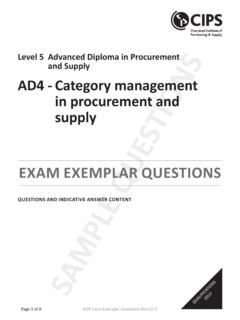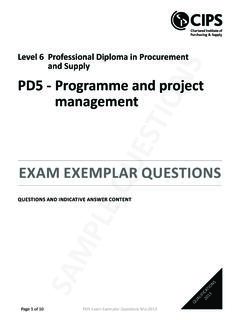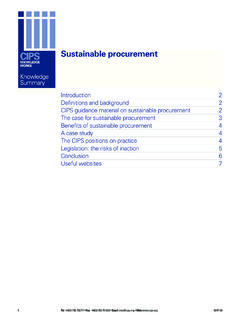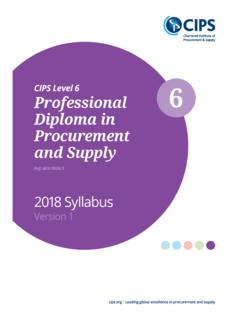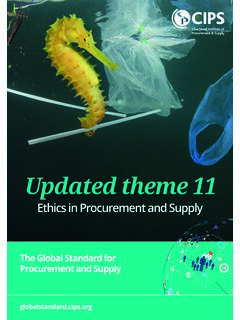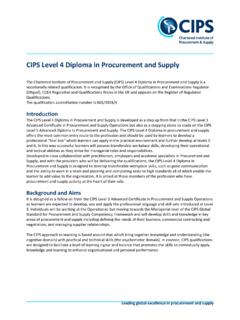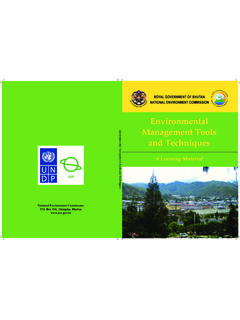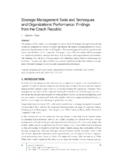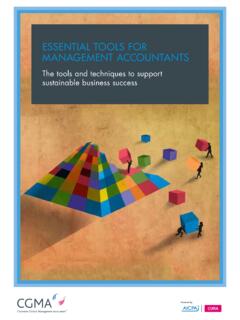Transcription of Stakeholder Identification and Management Tools Guidance ...
1 Leading global excellence in procurement and supply Title Description Stakeholder Identification and Management Tools Guidance Notes The document outlines the CIPS Stakeholder Identification and Management Tools created to help you to identify and manage your stakeholders more effectively. CIPS members can record one CPD hour This knowledge paper is supportive of Procurement professionals operating at operational level of the CIPS Global Standard Knowledge Tools CIPS 2020 1 CIPS Stakeholder Identification and Management Tools Guidance Notes Stakeholders are any individual or organisation that has an interest in or can be affected by a project, product, service or venture.
2 In any activity an organisation undertakes, whether strategic, operational or tactical, the activity can only be successful with the input, commitment and support of its key stakeholders. Identifying stakeholders, then engaging, gaining and maintaining their support and commitment is a continuous process. Stakeholders can be classified into three areas internal, connected and external. This classification depends on their position in relation to the organisation or project. The Identification of stakeholders is important. Without correctly identifying stakeholders and ensuring their inclusion, problems could develop. Once identified the individuals or organisations need to be classified, engaged and interacted with as well as being managed appropriately to ensure the outcomes are as required.
3 Through positive engagement with stakeholders, project managers, procurement managers and purchasing staff will be able to improve the quality of the outcome. This is because stakeholders can provide important and often unknown information as well as support once communication takes place rather than putting obstacles in the way of progress. If stakeholders are not identified and engaged with, this can present risks for the project outcome. Potentially if the correct stakeholders are not identified and managed effectively deadlines could be missed, budgets could present variances and ultimately and the worst possible scenario is that the project could fail.
4 You can also access further CIPS Stakeholder Guidance here. This document will cover the following Tools which CIPS members can download here. Tools Types of Stakeholder Stakeholder Identification brainstorming Cross Functional Teams Stakeholder Identification techniques Stakeholder engagement Mendelow Stakeholder mapping template RACI RACI template Stakeholder Management Stakeholder interaction Conflict Resolution Knowledge Tools CIPS 2020 2 1. Types of Stakeholder This model shows the three different categories of stakeholders.
5 Internal, connected and external. Internal stakeholders are individuals that are connected very closely to an organisation. They are people that have a strong influence on how the organisation is run and its success. Internal stakeholders could be employees, business owners or directors. Connected stakeholders are individuals or organisations that have a relationship in a contractual capacity to a business or project. Connected stakeholders can have a financial or legal connection to the organisation. Examples of connected stakeholders include shareholders, customers and suppliers. External stakeholders are quite diverse and are individuals or organisations that are not directly linked or contractually obligated to an organisation or a project.
6 Examples of external stakeholders include the government who are enforcing the rules and regulations that must be adhered to, the community and the pressure groups ( environmental or ethical activists). (Source: Jarvis-Grove, 2020) Knowledge Tools CIPS 2020 3 2. Stakeholder Identification brainstorming This model should be used at the outset of any project whether that be the procurement or sourcing of a new item, a modified rebuy or a straight rebuy. By identifying the stakeholders who will have an impact on the outcome of the project, the process can be managed effectively.
7 This model shows the questions that can be considered in a brainstorming session with cross-functional team members. By asking the questions outlined in the model a good amount of relevant stakeholders should be identified. (Source: Jarvis-Grove, 2020) Cross Functional Teams (Source: Jarvis-Grove, 2020) Knowledge Tools CIPS 2020 4 3. Stakeholder Identification techniques This model outlines techniques that can be used as aids in the Identification of stakeholders. In some situations the opportunity to engage or create a cross-functional team is not possible and in such circumstances this model may assist in helping to recognise the stakeholders for a project.
8 This model suggests techniques such as conducting research, referring to one s own knowledge, using brainstorming within the company or department, referring to previous documentation or media reports, communicating the objectives to establish if there is anyone who may object or add value, hold meetings and use STEEPLE to investigate the macro/external factors that may then present new and previously unknown stakeholders. (Source: Jarvis-Grove, 2020) Knowledge Tools CIPS 2020 5 4. Stakeholder engagement Stakeholder engagement is important throughout the duration of the project.
9 By following the five stages shown in the Stakeholder engagement model engagement should be apparent throughout. It is important to create a strategy of how engagement is going to be created and this should include the current vision and a preview into future objectives. Stakeholder mapping using Mendelow s matrix then should take place. Once stakeholders have been mapped the preparation of how the engagement will happen should be conducted. Focus should be placed on long term wins and future objectives. The engagement itself now commences ensuring that stakeholders are listened to and any tension or conflict is managed effectively and professionally. From the engagement feedback should be sought and acted upon to ensure the stakeholders needs have been met.
10 (Source: Jarvis-Grove, 2020) Knowledge Tools CIPS 2020 6 5. Mendelow Once the stakeholders have been identified they can be categorised. By categorising Stakeholder into four different quadrants, procurement professionals can understand the amount of engagement that is needed as well as the level of information that needs to be shared. Mendelow s Stakeholder Mapping model. This model has two axes the horizontal axis shows the level of interest that the Stakeholder is perceived to have. The left side of the axis represents low interest and the right hand side shows high interest.


